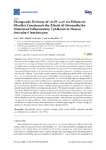Mostrar o rexistro simple do ítem
Therapeutic Delivery of rAAV sox9 via Polymeric Micelles Counteracts the Effects of Osteoarthritis-Associated Inflammatory Cytokines in Human Articular Chondrocytes
| dc.contributor.author | Urich, Jonas | |
| dc.contributor.author | Cucchiarini, Magali | |
| dc.contributor.author | Rey-Rico, Ana | |
| dc.date.accessioned | 2020-07-01T09:12:27Z | |
| dc.date.available | 2020-07-01T09:12:27Z | |
| dc.date.issued | 2020-06-25 | |
| dc.identifier.citation | Urich, J.; Cucchiarini, M.; Rey-Rico, A. Therapeutic Delivery of rAAV sox9 via Polymeric Micelles Counteracts the Effects of Osteoarthritis-Associated Inflammatory Cytokines in Human Articular Chondrocytes. Nanomaterials 2020, 10, 1238. https://doi.org/10.3390/nano10061238 | es_ES |
| dc.identifier.issn | 2079-4991 | |
| dc.identifier.uri | http://hdl.handle.net/2183/25841 | |
| dc.description.abstract | [Abstract] Osteoarthritis (OA) is a prevalent joint disease linked to the irreversible degradation of key extracellular cartilage matrix (ECM) components (proteoglycans, type-II collagen) by proteolytic enzymes due to an impaired tissue homeostasis, with the critical involvement of OA-associated pro-inflammatory cytokines (interleukin 1 beta, i.e., IL-1β, and tumor necrosis factor alpha, i.e., TNF-α). Gene therapy provides effective means to re-establish such degraded ECM compounds by rejuvenating the altered OA phenotype of the articular chondrocytes, the unique cell population ubiquitous in the articular cartilage. In particular, overexpression of the highly specialized SOX9 transcription factor via recombinant adeno-associated viral (rAAV) vectors has been reported for its ability to readjust the metabolic balance in OA, in particular via controlled rAAV delivery using polymeric micelles as carriers to prevent a possible vector neutralization by antibodies present in the joints of patients. As little is known on the challenging effects of such naturally occurring OA-associated pro-inflammatory cytokines on such rAAV/polymeric gene transfer, we explored the capacity of polyethylene oxide (PEO) and polypropylene oxide (PPO)-based polymeric micelles to deliver a candidate rAAV-FLAG-hsox9 construct in human OA chondrocytes in the presence of IL-1β and TNF-α. We report that effective, micelle-guided rAAV sox9 overexpression enhanced the deposition of ECM components and the levels of cell survival, while advantageously reversing the deleterious effects afforded by the OA cytokines on these processes. These findings highlight the potentiality of polymeric micelles as effective rAAV controlled delivery systems to counterbalance the specific contribution of major OA-associated inflammatory cytokines, supporting the concept of using such systems for the treatment for chronic inflammatory diseases like OA. | es_ES |
| dc.description.sponsorship | This research was funded by the DEUTSCHE FORSCHUNGSGEMEINSCHAFT (DFG RE 328/2-1 to A.R.R., M.C.). | |
| dc.description.sponsorship | Deutsche Forschungsgemeinschaft; DFG RE 328/2-1 | |
| dc.language.iso | eng | es_ES |
| dc.publisher | MDPI | es_ES |
| dc.relation.uri | https://doi.org/10.3390/nano10061238 | es_ES |
| dc.rights | Atribución 4.0 Internacional (CC BY 4.0) | es_ES |
| dc.rights.uri | https://creativecommons.org/licenses/by/4.0/ | * |
| dc.subject | Osteoarthritis | es_ES |
| dc.subject | Human articular cartilage | es_ES |
| dc.subject | rAAV vectors | es_ES |
| dc.subject | SOX9 | es_ES |
| dc.subject | Polymeric micelles | es_ES |
| dc.subject | Pro-inflammatory cytokines | es_ES |
| dc.subject | IL-1β | es_ES |
| dc.subject | TNF-α | |
| dc.title | Therapeutic Delivery of rAAV sox9 via Polymeric Micelles Counteracts the Effects of Osteoarthritis-Associated Inflammatory Cytokines in Human Articular Chondrocytes | es_ES |
| dc.type | info:eu-repo/semantics/article | es_ES |
| dc.rights.access | info:eu-repo/semantics/openAccess | es_ES |
| UDC.journalTitle | Nanomaterials | es_ES |
| UDC.volume | 10 | es_ES |
| UDC.issue | 6 | es_ES |
| UDC.startPage | 1238 | es_ES |
| dc.identifier.doi | 10.3390/nano10061238 |
Ficheiros no ítem
Este ítem aparece na(s) seguinte(s) colección(s)
-
GI-TCMR - Artigos [129]






